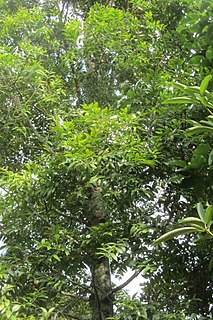
Nepenthes villosa, or the villose pitcher-plant, is a tropical pitcher plant endemic to Mount Kinabalu and neighbouring Mount Tambuyukon in northeastern Borneo. It grows at higher elevations than any other Bornean Nepenthes species, occurring at elevations of over 3,200 m (10,500 ft). Nepenthes villosa is characterised by its highly developed and intricate peristome, which distinguishes it from the closely related N. edwardsiana and N. macrophylla.

Agathis kinabaluensis is a tree of Borneo in the conifer family Araucariaceae. The specific epithet kinabaluensis is from the Latin, referring to the species being native to Mount Kinabalu in Sabah.
Meristogenys kinabaluensis is a species of frog in the family Ranidae. It is endemic to Borneo and is found in Sabah, Sarawak (Malaysia), and Kalimantan (Indonesia). The specific name refers to its type locality, Mount Kinabalu.

The Bornean leafbird, also known as the Kinabalu leafbird, is a species of bird in the family Chloropseidae. It is found in humid forest in Borneo, to which it is endemic. It has traditionally been considered a subspecies of the blue-winged leafbird, but differ in measurements and morphology, the female Borneon leafbird having a distinctive male-like plumage. The distribution of the two are known to approach each other, but there is no evidence of intergradation.

Knema is a genus of plant in family Myristicaceae, mostly consisting of small-medium trees found in lowland tropical forests from Asia to New Guinea. The highest diversity of species is in Borneo.
Knema elmeri is a species of plant in the family Myristicaceae. It is a tree found in Borneo.
Knema glaucescens is a species of plant in the family Myristicaceae. It is native to Sumatra, Peninsular Malaysia, Singapore and Borneo. However, a morpho-taxonomic study of fossil leaves assemblage discovered from the upper part of the Siwalik succession of sediments of Papum Pare district, Arunachal Pradesh, India, had shape, base and venation pattern comparable to Knema glaucescens (Myristicaceae).

Knema globularia is a species of plant in the family Myristicaceae. It is a tree found in Cambodia, China, India, Indonesia, Laos, Malaysia, Myanmar, Singapore, Thailand, and Vietnam.
Knema glomerata is a species of plant in the family Myristicaceae. It is a tree found in Borneo, the Moluccas and the Philippines.
Knema intermedia is a species of plant in the family Myristicaceae. It is found in Sumatra, Peninsular Malaysia, Singapore, Java and Borneo.
Knema latifolia is a species of plant in the family Myristicaceae. It is a tree found in Sumatra and Borneo.
Knema rufa is a species of plant in the family Myristicaceae. It is a tree endemic to Borneo.

Prunus kinabaluensis is a species of flowering plant in the family Rosaceae. It is found in Malaysia and the Philippines.
As of July 2016, the International Union for Conservation of Nature (IUCN) lists 238 conservation dependent species. 0.29% of all evaluated species are listed as conservation dependent. The IUCN also lists seven subspecies and five varieties as conservation dependent.

The World's 25 Most Endangered Primates is a list of highly endangered primate species selected and published by the International Union for Conservation of Nature (IUCN) Species Survival Commission (SSC) Primate Specialist Group (PSG), the International Primatological Society (IPS), Global Wildlife Conservation (GWC), and Bristol Zoological Society (BZS). The IUCN/SSC PSG worked with Conservation International (CI) to start the list in 2000, but in 2002, during the 19th Congress of the International Primatological Society, primatologists reviewed and debated the list, resulting in the 2002–2004 revision and the endorsement of the IPS. The publication was a joint project between the three conservation organizations until the 2012–2014 list when BZS was added as a publisher. The 2018–2020 list was the first time Conservation International was not among the publishers, replaced instead by GWC. The list has been revised every two years following the biannual Congress of the IPS. Starting with the 2004–2006 report, the title changed to "Primates in Peril: The World's 25 Most Endangered Primates". That same year, the list began to provide information about each species, including their conservation status and the threats they face in the wild. The species text is written in collaboration with experts from the field, with 60 people contributing to the 2006–2008 report and 85 people contributing to the 2008–2010 report. The 2004–2006 and 2006–2008 reports were published in the IUCN/SSC PSG journal Primate Conservation,, since then they have been published as independent publications.
Chionanthus kinabaluensis is a tree in the family Oleaceae.
Sphenomorphus kinabaluensis is a species of skink found in Malaysia.

Tenompok Forest Reserve is a protected forest reserve in Ranau District of West Coast Division, Sabah, Malaysia. It was designated as a Class 1 Forest Reserve by the Sabah Forestry Department in 1984. Its area is 1,984 hectares (19.84 km2). A former reserve, the Kampung Bundu Tuhan Native Residence Reserve, occupied what is now the eastern portion of Tenompok. The reserve is mountainous, reaching 1,660 metres (5,450 ft) above sea level. Vegetation consists of lower montane forest and montane kerangas forest. Both share a similar species composition, although trees in montane keranga forests are smaller. The reserve's Tomis River is a tributary of the Tuaran River. The area of the reserve has never received significant logging, aside from small amount near what are now its borders. This small logging is thought to be carried out by nearby villages for local use. There is also some agricultural encroachment. The reserve lies between Kinabalu Park and Crocker Range National Park. One farmer has a house within the reserve. There are several settlements around the reserve, along with agricultural land.








